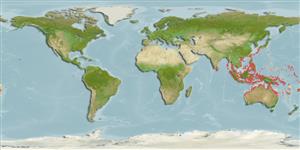Common names from other countries
Classification / Names / Names
Nomi Comuni | Sinonimi | Catalog of Fishes (gen., sp.) | ITIS | CoL | WoRMS
Environment: milieu / climate zone / depth range / distribution range
Ecologia
Associati a barriera corallina; distribuzione batimetrica 0 - 6 m (Ref. 99823). Tropical
Indo-West Pacific.
Length at first maturity / Size / Peso / Age
Maturity: Lm ? range ? - ? cm Max length : 12.0 cm CW maschio/sesso non determinato; (Ref. 343)
Surface of carapace smooth, sometimes with low pubescence; ridges distinct; front with 6 lobes, median 4 lobes truncate, lateral 2 lobes rounded. Color: usually bright red overall, but sometimes green, or with a mixture of red and green. Easily distinguished by its spinose palm and the bright red coloration.
Also caught by nets. Intertidal to subtidal (Ref. 106854).
Life cycle and mating behavior
Maturità | Riproduzione | Deposizione | Uova | Fecundity | Larve
Members of the order Decapoda are mostly gonochoric. Mating behavior: Precopulatory courtship ritual is common (through olfactory and tactile cues); usually indirect sperm transfer.
Ng, P.K.L. 1998. (Ref. 343)
IUCN Red List Status (Ref. 130435)
CITES status (Ref. 108899)
Not Evaluated
Not Evaluated
Human uses
Pesca: commerciale
| FishSource |
Strumenti
Fonti Internet
Estimates based on models
Preferred temperature
(Ref.
115969): 24.9 - 29.3, mean 28.6 (based on 2437 cells).
Vulnerability
Low vulnerability (10 of 100).
Price category
Unknown.
